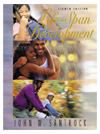 |  Life-Span Development, 8/e John W. Santrock,
University of Texas - Dallas
Early Adulthood Socioemotional Development in Early Adulthood
Chapter ObjectivesI.Discuss continuity and discontinuity from childhood to adulthood. |
 |  |  | II.Address how temperament and attachment influence adulthood. |
 |  |  | III.Elaborate on the factors that motivate attraction. |
 |  |  | IV.Discuss Erik Erikson's sixth stage of cognitive development. |
 |  |  | V.Define the three levels of relationship maturity. |
 |  |  | VI.Indicate ways in which adults balance intimacy and independence. |
 |  |  | VII.Differentiate between romantic love and affectionate love, then explain Sternberg's triangular theory of love. |
 |  |  | VIII.Discuss friendship and related gender differences. |
 |  |  | IX.Define loneliness and ways to decrease it. |
 |  |  | X.Describe the stages of the family life cycle. |
 |  |  | XI.Explain recent marital trends and how the view of marriage differs throughout the world. |
 |  |  | XII.Elaborate on marital myths, what makes marriages work, and the benefits of a good marriage. |
 |  |  | XIII.Discuss gender differences in expectations for marital relationships. |
 |  |  | XIV.Explain the expectations of parenting and common parenting myths. |
 |  |  | XV.Elaborate on the diversity of adult lifestyles. |
 |  |  | XVI.Address how women develop during early adulthood. |
 |  |  | XVII.Address how men develop during early adulthood. |
|



 2002 McGraw-Hill Higher Education
2002 McGraw-Hill Higher Education